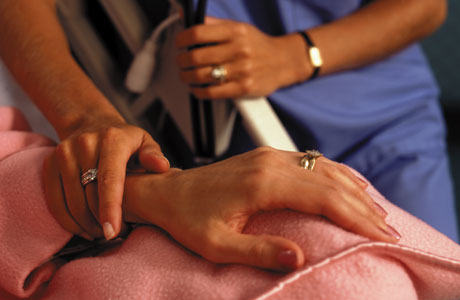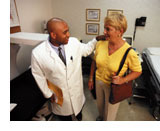- All About Animals
- The magazine for animal lovers.

- For a complimentary copy please telephone 0870 2406871
- Email the Editor

- Write with your opinion on the magazine and life in general after retirement. Click here.
- Register your vote
- Should workers be encouraged by their employers to stay on after retirement?

Recognising angina
Not so long ago people received the news of angina like a death sentence.
It was accepted as the beginning of an inevitable progress towards a heart attack, and that, in turn, meant at best a life as an invalid, and at worst, sudden death.
If there is one message I would like to put across it is that these attitudes are outdated and should be forgotten. If you have angina you can take advice on self-management and medical treatment that will almost certainly allow you to live a normal, satisfying life. You may also need some form of operation to help your coronary circulation, but that is now so routine that is should raise no fears for anyone undergoing it.
Much of the fear can also be taken out of heart attacks. If you know a little about heart attacks, then you can help yourself through the worst period. You will understand why you are receiving the investigations and treatment, and will find it easier to follow your doctors’ advice in the ensuing months and years. Remove the mystery, and you remove a lot of the fear.
Fear is a very destructive emotion, especially for the heart. It releases chemicals into the bloodstream that put up the blood pressure and cause the heart to race and demand more oxygen. It can stimulate the very event that you fear. Once you lose it, you will already have made the first step towards healing and full recovery.
Angina – is it the heart, or something else?
Angina is simply the medical word for pain. Angina pectoris means pain in the chest, and the two words together have slipped into common usage as meaning heart pain.
Strictly that is not always the case. Many pains in the chest have no connection with the heart. Problems in the chest and upper back that can produce pain include cramp or spasm in the chest wall muscles, or acid irritation flowing up from the stomach into the gullet. Often pain in the chest is no more than indigestion. Nerve irritations, as from shingles, or an inflamed lung surface, as in pleurisy, can also cause severe chest pain.
So, when you complain about chest pain, expect your doctor to ask searching questions about it; the answers you give will narrow down the possible causes. The first will be about the character of the pain: can you describe exactly what it feels like in simple terms?
The characteristics of heart pain are fairly clearly defined. If you describe it in one of the following ways, it will raise your doctor’s suspicions:
- tightness around my chest
- a weight or pressure on my chest
- constriction in my chest an aching pain
- a dull pain
- a squeezing feeling
- it’s just sore the chest is being crushed
- there’s a band around my chest
- the tightness makes me breathless
If you describe the following your doctor will look for some other cause:
- it’s sharp like a knife cutting me
- it comes in stabs it feels like a stitch
- t’s like needles in the skin
- it shoots across my chest
- it’s worse if you press on it, or when I change position
- I can walk around all day with it
- it’s there all day, even when I’m resting
The next question is about where the pain is. The heart occupies a central-to-left position in the chest; heart pain, however, is not confined to the outline of the heart. It can spread up into the jaw, or down into an arm, into the back of the chest, or even into the upper stomach. It can feel as if it is vaguely in the center of the chest, or towards the left side. However, it is rare for it to be entirely right-sided, without some part of it crossing the midline into the left.
 An entirely right-sided pain is rarely cardiac in origin, unless you are one of a very rare breed, a ‘mirror-image’ twin. Some twins are born with all the main organs reversed in position, so that the heart tends more to the right, and the liver is on the left. When they develop angina it is on the right side.
The third question is when does the pain arise? Most angina starts with exercise. Physical effort brings it on, and resting relieves it. Your doctor will wish to know exactly how much exercise is needed to produce the pain, and how long it lasts when you rest.
An entirely right-sided pain is rarely cardiac in origin, unless you are one of a very rare breed, a ‘mirror-image’ twin. Some twins are born with all the main organs reversed in position, so that the heart tends more to the right, and the liver is on the left. When they develop angina it is on the right side.
The third question is when does the pain arise? Most angina starts with exercise. Physical effort brings it on, and resting relieves it. Your doctor will wish to know exactly how much exercise is needed to produce the pain, and how long it lasts when you rest.
Angina is graded according to how much exercise you can tolerate before the pain starts; from a few steps on the flat, through a brisk walk up a gentle slope, or climbing stairs, to running for a bus, digging, lifting weights, straining at the toilet or making love. Don’t hesitate to list all the times when you have noticed it: your doctor needs to know, and will not be embarrassed.
For a few people, angina comes on at rest or even wakes them out of sleep. This is a serious sign and needs urgent assessment in a specialist hospital department. Prompt investigation in these cases can prevent an imminent heart attack.
The final question is – what do you do when the pain starts? Try to walk through it, or stop until it goes away? Whatever you have done in the past, the right course is to stop and rest. The pain is a sign that your heart needs more oxygen and must relax, preferably lie down, and wait for half an hour or so after the attack before moving again.
You may find that difficult to accept, especially if you are busy and want to get on with your work. If that is how you feel, then the next few paragraphs may convince you otherwise. They explain exactly what is going on in the heart during an angina attack, and why you must obey the advice.
 The heart obeys a law as fundamental in biology as it is in the marketplace – supply and demand. The supply, in this case is the supply of blood in the coronary arteries carrying oxygen and glucose to fuel the beating of the heart muscle. The demand comes from the need for the heart muscle to beat so that the heart can supply blood to all other organs and tissues of the body. The more energy we expend, such as in physical exercise, or in digesting our food, or in solving an intellectual problem, the more blood the heart needs to pump to the muscles, gut and brain, respectively.
The heart obeys a law as fundamental in biology as it is in the marketplace – supply and demand. The supply, in this case is the supply of blood in the coronary arteries carrying oxygen and glucose to fuel the beating of the heart muscle. The demand comes from the need for the heart muscle to beat so that the heart can supply blood to all other organs and tissues of the body. The more energy we expend, such as in physical exercise, or in digesting our food, or in solving an intellectual problem, the more blood the heart needs to pump to the muscles, gut and brain, respectively.
Whenever the demand on the heart rises above the resting level, the coronary arteries must open up further and supply a better flow of blood to the myocardium. The heart beats faster, and more strongly, and needs to use up more oxygen and glucose to do so.
All this is very well catered for in the healthy heart, where the walls of the coronary arteries are smooth and elastic, and free of any obstruction. The problem starts when plaques of atheroma start to narrow and distort them. Such narrowed areas not only obstruct the free flow of blood, they are rigid, their elastic tissue being replaced by stiff, unyielding fibrous scars. They cannot open up to allow the extra blood through.
This means that the heart reaches a point at which the muscle beyond the narrowed segment of artery cannot get enough oxygen to fuel its contractions. This makes it impossible for the heart muscle to work efficiently, so that it becomes laden with acid residues of glucose. These chemical residues are the cause of the pain and other angina symptoms. When the heart muscle’s demand for oxygen outstrips its supply by the coronary arteries, this is called medically ischaemia, a word that simply means a state of lack of blood. Coronary artery disease causing angina therefore has another name – ‘ischaemic heart disease’.
An extract from ‘Heart Attacks Prevent and Survive’ by Dr Tom Smith, by kind permission of Sheldon Press
